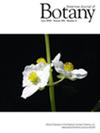Pandanus plastomes decoded: When climate mirrors morphology and phylogenetic relationships
Abstract
Premise
Pandanus Parkinson (Pandanaceae) is a large genus of paleotropical tree-like monocots. Previous studies using small DNA regions questioned the monophyly of the seven Pandanus subgenera, but low phylogenetic branch support hindered further investigations. We aimed to (1) test Pandanus subgeneric monophyly, (2) identify clade morphological synapomorphies, (3) investigate correlations between leaf anatomy of water storage tissue and climatic differentiation across clades, and (4) construct hypotheses on the genus' spatiotemporal history.
Methods
We sequenced 50 Pandanus species using genome skimming and reconstructed plastomes with MITObim. We inferred partitioned RAxML phylogenetic trees to test subgeneric monophyly using Shimodaira–Hasegawa tests. We inferred a partitioned dated BEAST phylogenetic tree used for ancestral state reconstructions of morphological traits. Phylogenetic clades were used to compare climatic (Bioclim) and soil (UNESCO Digital Soil Map) conditions using random forests. We correlated present morphology and climatic niche with past climate events.
Results
Our phylogenetic analyses revealed two clades and four subclades. Only subgenus Coronata was monophyletic. Staminate synapomorphies were identified for three subclades. Hypertrophied and hyperplasic water-storage tissue was a synapomorphy for clade II, correlating with more seasonal temperature and precipitation regimes and more well-draining soil. Clades differentiated during the advent of the Southeast Asian monsoon in the early Miocene, whereas subclades differentiated during the Miocene Thermal Maximum.
Conclusions
Pandanus subgeneric classification needs to be revised. Hypertrophied hyperplasic water-storage tissue is a key trait in Pandanus evolution, possibly explaining climatic and biogeographic patterns because it is key to maintaining photosynthesis during periods of hydric stress.

 求助内容:
求助内容: 应助结果提醒方式:
应助结果提醒方式:


